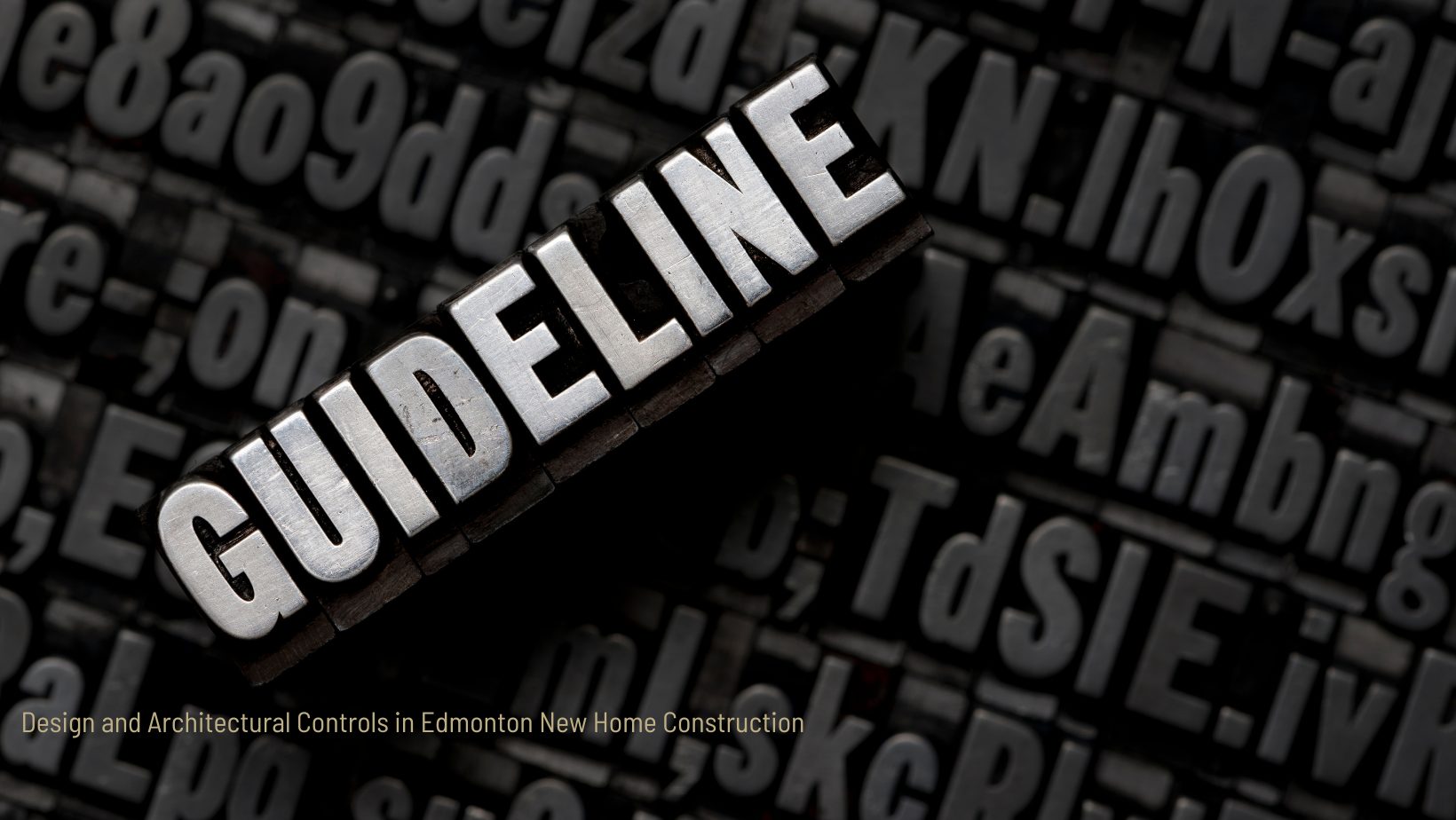When building a new home in Edmonton, there’s more to the process than selecting a floor plan or choosing finishes. Design and architectural controls play a crucial role in shaping the aesthetic, functional, and communal aspects of neighbourhoods. These guidelines help maintain the visual harmony and value of communities, ensuring they remain desirable for decades to come.
In this blog, we’ll delve into what architectural controls are, why they matter, and how they influence new home construction in Edmonton. By the end, you’ll have a comprehensive understanding of how these controls shape Edmonton’s real estate market and why they are a vital consideration for prospective homeowners.
What Are Architectural Controls?
Architectural controls are guidelines or rules established by developers to regulate the design and construction of homes within a specific neighbourhood. These controls ensure that all homes meet a certain standard and align with the overall vision for the community.
Key elements of architectural controls include:
- Exterior Design: Restrictions on home façades, rooflines, and materials.
- Color Schemes: Approved palettes to maintain aesthetic consistency.
- Landscaping Requirements: Minimum standards for front yards, trees, and shrubbery.
- Lot Coverage: Rules about how much of the lot can be covered by the building.
- Fencing and Driveways: Specifications for materials and designs.
In Edmonton, many new developments, particularly those in master-planned communities, have strict architectural controls to preserve the integrity and appeal of the area.
Why Are Architectural Controls Important?
1. Preserving Community Aesthetics
Architectural controls help maintain a cohesive look throughout a neighbourhood. By enforcing consistency in design and materials, these guidelines prevent the area from feeling disjointed or visually chaotic. This is especially important in Edmonton’s growing communities, where a polished appearance can significantly enhance curb appeal.
2. Enhancing Property Values
Homes in neighborhoods with strict architectural controls often retain or even increase their value over time. A well-designed community appeals to buyers and fosters a sense of pride among homeowners, making it a sound long-term investment.
3. Encouraging Sustainability
Modern architectural controls often incorporate eco-friendly guidelines, such as requiring energy-efficient windows, solar-ready roofs, or native landscaping. Edmonton’s emphasis on sustainability aligns with broader trends in green building practices.
4. Defining Neighbourhood Identity
Each community in Edmonton is unique, and architectural controls help reinforce this identity. Whether it’s a modern, minimalist vibe or a charming, traditional aesthetic, these controls shape the neighbourhood’s personality.
5. Ensuring Safety and Functionality
Architectural controls go beyond aesthetics to address practical considerations like drainage, lot grading, and driveway placement. These measures improve safety and functionality for residents.
Edmonton’s Approach to Architectural Controls
Edmonton’s rapid growth has led to the development of diverse neighbourhoods, each with its distinct style and character. Master-planned communities such as Windermere, Riverstead at Keswick, and Chappelle Gardens are prime examples of how architectural controls shape the city’s landscape.
1. Designing for Edmonton’s Climate
Architectural controls in Edmonton often account for the city’s unique weather conditions. Requirements for durable siding, efficient insulation, and proper drainage systems reflect the need to withstand harsh winters and rainy springs.
2. Incorporating Local Heritage
Some communities integrate Edmonton’s cultural heritage into their design guidelines. This includes nods to Indigenous influences, prairie-style homes, or architectural elements that reflect the city’s historical development.
3. Encouraging Innovation
While architectural controls ensure consistency, they also leave room for creativity within set boundaries. Builders in Edmonton often innovate within these parameters, offering homeowners unique yet compliant designs.
The Role of Design in New Home Construction
Design is at the heart of every successful new home build. While architectural controls set the framework, it’s the design process that brings a homeowner’s vision to life.
1. Customizing Within Guidelines
In Edmonton, buyers often work with builders to customize their homes while adhering to architectural controls. This balance ensures individuality without compromising the community’s overall aesthetic.
2. Functional Layouts
Modern homeowners prioritize functionality, and Edmonton’s new homes reflect this trend. Open-concept layouts, multi-use spaces, and efficient storage solutions are common features.
3. Focus on Sustainability
Green building practices are increasingly important in Edmonton. From energy-efficient appliances to solar-ready designs, the emphasis on sustainability aligns with global trends and local climate goals.
4. Blending Style and Practicality
Design in new homes is about more than looks; it’s also about how a home functions. Features like mudrooms, heated garages, and large windows that maximize natural light are practical yet stylish elements commonly found in Edmonton homes.
Architectural Controls in Edmonton Neighborhoods: Case Studies
1. Windermere
Known for its upscale homes and luxurious amenities, Windermere’s architectural controls prioritize high-quality materials, timeless designs, and cohesive landscaping. The result is a sophisticated community that attracts discerning buyers.
This master-planned community boasts a distinct blend of modern and traditional styles. Architectural controls here emphasize harmony with the surrounding natural environment, incorporating walking trails, parks, and green spaces.
Chappelle Gardens’ vibrant and family-friendly atmosphere is enhanced by architectural controls that encourage unique yet harmonious designs. Bright, cheerful color palettes and contemporary styles define this community.
Challenges with Architectural Controls
While architectural controls offer numerous benefits, they also come with challenges.
1. Limited Design Flexibility
Some homeowners may feel restricted by the rules, especially if they have a bold or unconventional vision for their home.
2. Higher Construction Costs
Meeting architectural controls can sometimes increase building costs due to requirements for premium materials or specific design features.
3. Approval Delays
Builders must often submit plans for approval to ensure compliance, which can extend the timeline for construction.
Tips for Navigating Architectural Controls in Edmonton
- Work with Experienced Builders
Choose a builder familiar with Edmonton’s architectural controls. Their expertise will streamline the approval process and help you design a compliant home. - Understand the Guidelines
Before purchasing a lot, review the community’s architectural controls. This ensures your vision aligns with the neighborhood’s standards. - Plan for the Long Term
Consider how the architectural controls will impact the resale value of your home. A well-designed community often attracts buyers, making it easier to sell in the future. - Embrace the Benefits
Rather than viewing architectural controls as limitations, see them as an opportunity to build a home that fits seamlessly into a beautiful, cohesive neighbourhood.
The Future of Design and Architectural Controls in Edmonton
As Edmonton continues to grow, architectural controls will play an even more significant role in shaping the city’s communities. Emerging trends include:
- Smart Home Integration: Controls that encourage or require smart home features.
- Eco-Friendly Materials: Increased emphasis on sustainable and locally sourced materials.
- Mixed-Use Developments: Guidelines that accommodate diverse housing types and commercial spaces.
- Inclusivity: Designs that prioritize accessibility for all residents.
Conclusion
Design and architectural controls are integral to Edmonton’s new home construction landscape. They ensure that neighbourhoods remain visually appealing, functionally sound, and highly desirable for residents. While these guidelines may seem restrictive, they offer long-term benefits that far outweigh the challenges.
By understanding and embracing architectural controls, homeowners can create a space that reflects their personality while contributing to the overall beauty and harmony of the community. Whether you’re building your first home or upgrading to a custom design, these principles will guide you toward a successful and satisfying construction journey.
Have more questions about Design and Architectural Controls in Edmonton New Home Construction? Contact Chris Reid Edmonton REALTOR®
For more insights into Edmonton’s real estate market, follow me on Facebook, Instagram, and YouTube. Stay updated on the latest new build opportunities and exclusive deals!

 Facebook
Facebook
 X
X
 Pinterest
Pinterest
 Copy Link
Copy Link

